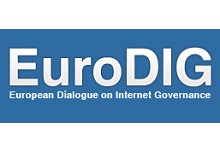Building on a blockchain
8 Jun 2018 02:00h
Event report
This session was part of the EuroDIG educational track and was moderated by Mr Arvin Kamberi (Multimedia Coordination, DiploFoundation). The goal of the session was to explain the basics of blockchain technology.
Participants who wanted to discuss more complex issues around this technology were invited to follow the plenary session, ‘Blockchain – a competition to governments?’.
Mr Walid Al-Saqaf (Senior Lecturer, Södertörn University) explained in a simplified way, how blockchain technology works and why it is seen as revolutionary. The Internet has three main characteristics: it is decentralised, transparent (because the TCP/IP protocols are open source), and it is secure (we are confident that our data packets will be delivered along the network). These attributes allow us to communicate globally and on a massive scale. However, in the current system, when we send data via intermediaries, the content becomes duplicated. Blockchain technology does not allow for this duplication. Al-Saqaf stressed that blockchain is revolutionary because it allows for a decentralised, open, peer-to-peer (P2P) communication in which packages travel from one owner to the other directly. On a blockchain network, every transaction operates on the distributed application architecture and is recorded on the distributed ledger. ‘No one can change the ledger records without the consensus of the whole network’, Al-Saqaf noted. He reminded the audience that bitcoin is just one of the applications running on blockchain.
After the simplified explanation of how blockchain works, the audience participated in an interactive game that showcased how blocks inside a chain are created. Eight volunteers from the audience acted as ‘miners’ and block creators. They monitored all transactions and ensured the validity of the distributed ledger. Their trading currency was ‘chocolate coins’. Through a series of transfers of the coin, the audience learned why blockchain is tamper-proof.
Following the simulation, Mr Jörn Ergbuth (Blockchain and Data Protection Consultant) explained the system of smart contracts. Ergbuth noted that although there is no clear definition of the term, it has some main characteristics. Smart contracts are automated, online, secure, and always part of a code. The question is therefore, can code be law? According to Ergbuth, the essence of contracts is the mutually valid agreement, written in an understandable language, and smart contracts can be law. The benefit of smart contracts is that the ledger on blockhain is transparent, and the transaction is received, stored, and transferred once the transaction is confirmed and executed. Ergbuth also highlighted that smart contracts are small scripts on blockchain that can be used to do a series of contracts. Furthermore, smart contracts change over time and are still not perfectly developed. This raises the question for the multistakeholder model on how to govern smart contracts, and potentially, whether a central authority can be established to control their development and execution. Other open questions for smart contracts involve regulation, dispute resolution, privacy, and mediating their attractiveness for criminal business.
Related topics
Related event

